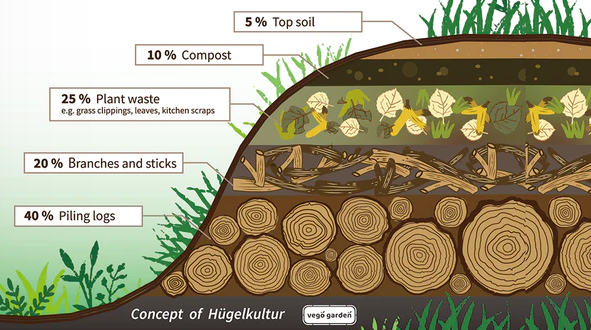In the realm of sustainable gardening practices, hugelkultur stands as a shining example of nature-inspired innovation. This ancient method, originating in Eastern Europe, has gained renewed interest among eco-conscious gardeners and homesteaders around the world. Hugelkultur, which translates to "hill culture" or "mound culture," involves creating raised garden beds using a combination of organic materials, fostering a self-sustaining and nutrient-rich environment for plants to thrive. Let's delve into the fascinating world of hugelkultur gardening and uncover its numerous benefits.
Building the Foundation: How Hugelkultur Works
At its core, hugelkultur revolves around the concept of utilizing decaying wood and organic matter to create a nutrient-dense growing medium. Gardeners begin by layering logs, branches, and woody debris at the bottom of a raised bed. These materials not only form a solid foundation but also act as a sponge, soaking up moisture and gradually releasing it to the plants above. This natural water retention system reduces the need for frequent watering, making hugelkultur an ideal choice for arid climates or water-conscious gardeners.
Above the woody base, layers of leaves, grass clippings, straw, compost, and soil are added, creating a gradual transition from coarse to fine organic matter. As these materials break down over time, they release essential nutrients into the soil, providing a steady supply of nourishment to plants. This organic decomposition also generates heat, which can extend the growing season and potentially offer protection against frost.
Source: Vego Garden
The Benefits of Hugelkultur Gardening
Water Efficiency: Hugelkultur beds excel in water conservation due to their inherent ability to retain moisture. The woody base acts like a reservoir, slowly releasing water to plant roots as needed. This characteristic reduces water consumption and minimizes the risk of waterlogged soil.
Nutrient Richness: As the organic materials decompose, they enrich the soil with essential nutrients, creating a fertile and vibrant environment for plant growth. This natural fertilization process reduces the reliance on synthetic fertilizers.
Improved Soil Structure: Hugelkultur promotes healthy soil structure by enhancing aeration, drainage, and microbial activity. The gradual breakdown of organic matter encourages the development of beneficial microorganisms, which contribute to overall soil health.
Low Maintenance: Once established, hugelkultur beds require minimal maintenance. The self-sustaining nature of the system means less frequent watering, weeding, and fertilization, allowing gardeners to enjoy the fruits of their labor with reduced effort.
Biodiversity: Hugelkultur beds create diverse microenvironments, attracting a variety of insects and beneficial organisms. This biodiversity can contribute to natural pest control and pollination.
Longevity: Hugelkultur beds have the potential to remain productive for several years, gradually breaking down and renewing themselves over time. This longevity makes them a practical and sustainable gardening option.
Embracing an Ancient Wisdom
Hugelkultur gardening is a testament to the ingenuity of nature-inspired practices. By mimicking natural processes and harnessing the power of organic decomposition, gardeners can cultivate thriving and resilient ecosystems. Whether you're a seasoned gardener or a novice with a passion for sustainability, hugelkultur offers a unique and rewarding way to connect with the land, promote biodiversity, and nurture a greener future—one mound of soil at a time.

